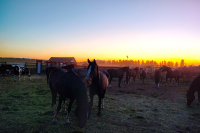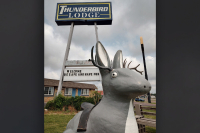The ties that bind Trantham family uses music to bind generations together
 When Doug Trantham was a kid, he wanted to impress his father.
When Doug Trantham was a kid, he wanted to impress his father.
“I was 10-years-old when my dad made a banjo,” he said. “That was around the house and I got interested in playing it. Banjo is my heart instrument. I learned to play clawhammer style and loved it.”
Picking up the instrument, Trantham had an urge to show his dad what he was made of.
Raymond Fairchild and a vanishing tradition
 By Charles and Cynthia Seeley • Guest Columnists
By Charles and Cynthia Seeley • Guest Columnists
I am a visitor to Maggie Valley. My husband, two friends and I chose this area of the North Carolina mountains as our vacation destination by pure chance. Our goal was to see the beautiful Smoky Mountains while doing a little sightseeing at some of the well-known tourist places in the area. Something happened, however that made the Biltmore Estate, Dollywood and casinos, although nice, irrelevant. And that was Raymond Fairchild and his Maggie Valley Opry.
On a recent Thursday evening, my husband and I went to hear him. We knew he was a five-time world-champion banjo player. That would have been enough — just to have the opportunity to hear banjo music from a renowned musician was all that we had expected. We came away with a lifetime experience and a respect for the musician and his colleagues that goes far deeper than an evening of entertainment.
An evening with Balsam Range: Pulling the strings of bluegrass, brotherhood and backwoods tradition
 The strings of tradition and progress echoed from the back alley.
The strings of tradition and progress echoed from the back alley.
Upon further inspection (and a lone door cracked open), the harmonic tone was radiating from the mandolin of Darren Nicholson.
WCU brass quintet takes music to Jamaican schoolchildren
 The Smoky Mountain Brass Quintet, quintet-in-residence at Western Carolina University, made a seven-day educational tour of Jamaica this summer to inspire the teaching and learning of brass instruments in the public schools there.
The Smoky Mountain Brass Quintet, quintet-in-residence at Western Carolina University, made a seven-day educational tour of Jamaica this summer to inspire the teaching and learning of brass instruments in the public schools there.
Performer or panhandler? Street musicians scarce where codes ban begging
The warm weather and sunshine brings a flurry of people to Waynesville’s downtown to enjoy the local fare — but it can also mean the beginning of busking season.
While Asheville is an epicenter for busking — slang for performing on the sidewalk in hopes of earning a few bucks from passersby — the phenomenon is fairly rare in downtown Waynesville. But every so often, someone will plop themselves down on a bench or take up a position along Main Street’s sidewalk and start crooning. For the most part, they are simply playing for fun.
“If they are just playing to play and it’s not causing a disturbance for somebody else, then we see no need (to address it),” said Waynesville Police Lt. Brian Beck.
But, if they decided to set out an instrument case, hat, jar or receptacle — or otherwise hint even slightly that donations are welcome — performers must have consent from the town.
In Waynesville, busking comes under the category of begging, which is banned per town ordinance. Performers used to have to receive express permission from the mayor himself to perform, but now what is needed is a permit. Buskers must fill out information with the planning and zoning office, which takes only a few minutes. Then, they would receive a permit from the town tax office at a cost of $25.
No permits have been issued for quite a while, however.
“I have not issued a permit for somebody playing an instrument since gosh, I don’t know when,” said James Robertson, the town tax collector.
That could be the reason why there have not been many, if any, problems during the past few years. However, in years prior, there were some issues — particularly with intoxicated individuals performing.
Enforcement is more report-based than anything else. The police will not stop just because they see someone performing. However, if the performer is noticeably causing problems or someone calls to complain, the police will respond.
“If a disturbance is taking place, we have to address it,” Beck said.
Like Waynesville, Sylva is not exactly hopping with buskers either, although the occassional college students from WCU have been known to play their guitar on benches.
“We don’t really have a glut of street performers here,” said Chris Cooper, a member of the Jackson County instrumental fusion band Noonday Sun. “It could just be early in the season.”
At most, Cooper said, he has only ever seen a couple of street performers, including a ukulele player and a saxophonist.
Sylva has stricter guidelines for performing on the town’s main roads. They must appear before the town board to request permission to play for donations.
However, buskers can play at festivals and the farmers market without any sort of permit or pre-approval.
Most businesses would not mind a little entertainment outside their doorstep.
“It is pretty OK with most of the shops around here,” Cooper said.
But town codes that prevent buskers from putting out a collection hat in Waynesville and Sylva could be part of the reason performers don’t take to the street in greater numbers.
Asheville has become a haven for buskers partially because it has no permitting process. Indeed, the vibrant and diverse busking scene is part of the city’s character.
Only performers who incorporate fire into their act are required to obtain a permit for safety reasons. That allows the fire department to keep tabs on them.
When walking downtown, it is difficult to turn a corner and not see at least one person busking. However, merchants irritated by buskers can legally ask them to move along.
“A business owner does have the right to ask them to leave if they are impeding business,” said Diane Ruggiero, superintendent of Cultural Arts in Asheville.
In general, though, business owners enjoy and welcome busking outside their doorstep.
“I think that that is one of the reasons that it works here. The business owners are receptive to it,” Ruggiero said. “A lot of them have good relationships with performers.”
And, although a few problems arise here and there, the system mostly works harmoniously.
Performers cannot stay in one place all day, pass a hat or sell merchandise. But, they can set out a hat or can or guitar case — a silent signal for donations. One thing that Ruggiero has tried to teach passersby is to ignore bad buskers.
Some people will give an ill-sounding musician or otherwise deficient performer money with the caveat that he or she stop or use the funds to take lessons. This doesn’t work, Ruggiero said. It only encourages them to continue.
“All you’ve done is given that bad musician a dollar,” Ruggiero said.
Listen to the music
Whether it’s called pickin’, groovin’ or jammin’ — every summer, Western North Carolina blends its majestic mountain views with its heritage music at various concerts and jam sessions.
Although each is different, the concept of the events is simple. Musicians come together from around Western North Carolina to play music.
“For musicians and listeners alike, the jam makes it possible to step back in time when life was basic, simple and unhurried. They all come for one thing — to learn, share and enjoy the enduring music that has wafted across the hills and hollers from the cabins, porches, school houses and church houses of Appalachia for centuries,” said Judy Sipes, an autoharp player who plays in Old Time Music Jam in the yard of the Oconaluftee Visitor Center at the entrance of the Great Smoky Mountain National Park.
Some jam sessions, like Pickin’ in the Park in Canton, result in a group of three or four artists playing in one area, surrounded by other gatherings of three or four musicians hosting their own pickin’ sessions. Spectators can move from group to group during the event. Others, including Pickin’ in the Square in Franklin, have open mics followed by a headlining band. Then, there are shows such as Concerts on the Creek in Sylva, which feature a scheduled band or musician each week.
Concerts on the Creek is a relatively young event that started four years ago as a once a month musical performance aimed at attracting more people to the downtown.
“At the time, it was the beginning of the economic recession, and we felt like this would be a great way to bring tourists into the area to do something for free,” said Julie Spiro, executive director of the Jackson County Chamber of Commerce and the Travel and Tourism Authority. Spiro added that the event also gives area residents something free and fun to do in their town.
Concerts on the Creek soon grew from a small monthly event to a weekly one that, on average, brings 600 to 700 people to downtown Sylva every Friday night. Balsam Range, which plays each year, draws about 1,5000 spectators.
“It sort of depends on the weather and the band,” Spiro said.
After last year, the event had gotten so big that the Jackson County chamber, the town of Sylva and the recreation park, who all sponsor Concerts on the Creek, were required to hire a police officer to patrol it this summer.
Although she does not have any concrete data, Spiro said that several businesses have told her that they see a bump in business as a result of the Concerts on the Creek.
“They are busier,” Spiro said.
There’s another undeniable drawing card for the outdoor music that fills the air on summer evenings in the mountains: it’s free.
“All you have to do is bring your chair and come downtown,” said Linda Schlott, director of the Franklin Main Street program.
More than 200 people turn out every Saturday night for Pickin’ on the Square in Franklin.
“People love Pickin’ on the Square,” Schlott said. “The entertainment is different every week. Some nights it is clogging; some nights it is 60s music; some nights it is bluegrass.”
One element of Pickin’ on the Square is a one-hour open mic session before the main band takes the stage, a local version of American Idol that gives anyone their chance in the spotlight.
Community jams
Gather round for some old-fashioned mountain music. Free. Bring a lawn chair or blanket.
Haywood County
• Pickin’ in the Park from 7 to 10 p.m. every Friday night at the Canton Recreation Park in Canton.
• Street dances from 6:30 to 9 p.m. on select Friday nights in front of the historic courthouse in downtown Waynesville. Mountains music, clogging and square dancing. June 22, July 6, July 20 and August 3.
Jackson County
• Concerts on the Creek from 7:30 to 9:30 p.m. every Friday night at Bridge Park in downtown Sylva. The complete 10-week schedule is as follows: Sundown (May 25); Vinyl Brothers Big Band (June 1); Rafe Hollister (June 8); Balsam Range (June 15); Mountain Faith (June 22); Buchanan Boys (June 29); The Johnny Webb Band (July 6); Empty Pockets (July 13); The Elderly Brothers (July 20); and Dashboard Blue (July 27).
• Groovin’ on the Green is held on the Cashiers Village Commons on Friday nights during summer, starting June 1. The series is sponsored by the Greater Cashiers Merchants Association. Artists include Hurricane Creek (June 1); Honeycutters (June 8); Rafe Hollister (June 15); Von Grey (June 22); Velvet Truckstop (July 6); One Leg Up (July 13); and Leigh Glass & The Hazards (July 27). 828.743.1630.
Macon County
• Pickin’ on the Square at 6:30 p.m. every Saturday night in downtown Franklin through Aug. 25. Open-mic, followed by main entertainment. The next 12-weeks of bands is as follows: The Johnny Webb Band (May 19), Sundown (May 26), Highway 76 (June 2), Heart of the South Band, featuring Earl Coward (June 9), The Elderly Brothers (June 16), The Tonesman (June 23), Tugelo Holler (June 30), Lisa Price Band (July 7), Miller Creek Bluegrass Band (July 14), Michael Reno Harrell (July 21) and Easy Street Band (July 28). 828.524.2516.
Swain County
• Old-time music jam from 1-3 p.m. the third Saturday of the month at the Oconaluftee Visitor Center in the Great Smoky Mountains National Park on U.S. 441 outside Cherokee. 828.452.1068.
• Community music jam from 6-7:30 p.m. each 1st and 3rd Thursday of the month at the Bryson City library in downtown Bryson City. 828.488.3030.
• Music in the Mountains from 6:30 to 8 p.m. every Saturday in downtown Bryson City. Artists include Boogertown Gap (June 2); Frank Lee, Isaac Deal and Bradley Adams (June 9); Juniper (June 16); Mountain Dew-et (June 23); The Barefoot Movement (June 30); The Josh Fields Band (July 14); Jakleg (July 21); and The Elderly Brothers (July 28).
Bringing improv to the traditional
With tunes that rush quickly along and take unexpected twists and turns, Sylva-based The Dan River Drifters are anything but lazy and predictable, like their name might suggest.
The band’s high-energy and sometime improvisational approach to bluegrass makes them an exciting group in which to listen.
Although they are relatively new to the Western North Carolina music scene, the group’s beginnings go back to a couple of the members’ childhood.
Long-time friends Jesse Lapinski and Andrew Lawson began playing open mic nights together and took the name The Dan River Drifters almost three years ago while attending Western Carolina University in Cullowhee. The calm, paddler–friendly Dan River runs through Stokes County, where Lapinski and Lawson lived as kids.
Over time, as the two made friends with other area musicians, the group expanded. Originally a duo, the band more than doubled to a quintet, adding Adam Bigelow, Tim Sheehan and Jesse’s younger brother Zach Lapinski.
“It just kind of fell into place,” Jesse said.
Jesse performs with the mandolin and guitar, while Lawson plays guitar and harmonica. Zach and Sheehan, who still attend WCU, play guitar and the five-string banjo, respectively. The most recognizable name on the band’s roster is Sylva Renaissance man Bigelow, who plays bass for the Drifters. Bigelow is heavily involved in many Jackson County community efforts, particularly environmental conservation. All five contribute to the group vocally.
“We are all good friends,” Lawson said.
Although bluegrass seems like the natural choice for bands in Western North Carolina, Sheehan was the person who really drew them to playing the genre, said Jesse, who used to play in a punk rock band.
At WCU, Jesse studied music education with a focus on jazz, from which the group took its improvisational style.
“Every time we do play, you will hear something new,” Jesse said.
The solo ad-libs give each band member to showcase his pickin’ skills.
“To me, when people solo, it’s like they are telling a story,” Jesse said.
During their shows, the Drifters play traditional bluegrass songs but mix in a fresh, high-energy sound. About one-third of the Drifters’ repertoire is songs they personally penned. Their tunes, most of which are collaborative efforts by Jesse and Lawson, take on some traditional bluegrass themes — murder ballads, moonshine and outlaws.
While the highest point in their career thus far came last April when they opened for the nationally known and locally loved Freight Hoppers, the Drifters most memorable performance was at a wedding in Cashiers with an enthusiastic audience. The wedding party had traveled in from Boston, and the Drifters had been asked to provide the music. Lawson said it was one of their best audiences.
“They loved it,” Lawson said. “I guess it makes them feel like they are from the mountains.”
Since most of its members have graduated from WCU, scheduling band practices has become more challenging. But, it has also allowed the band to expand its reach beyond Cullowhee and Sylva. Now that half the group lives in Asheville, the Drifters regularly perform at The Altamont Brewing Company and other venues around the city.
The next step is a CD — something they can give to venues to help them book gigs or sell to fans.
“Maybe a demo CD will get somebody to open the door for us,” Lawson said.
Hear them live
The Dan River Drifters will play at 8 p.m., April 14, at the Tuckaseegee Tavern on Depot Street in Bryson City. Or, catch them the following weekend on April 28 at Greening Up the Mountains in Sylva. The show begins at 11:45 a.m.
For a list of more performances or to hear their song “Blinkin’ Lincoln,” check out Dan River Drifters on Facebook.
Third time’s the charm for The Strand revival
The old Strand movie theater in downtown Waynesville is finally getting a new lease on life after two false starts in the past decade to revive the shuttered Main Street icon.
The building was bought in foreclosure last year by Rodney and Lorraine Conard, who have already begun renovations to transform it into a live performance venue.
“I have just always loved the building,” Rodney said, ever since he watched Flash Gordon travel to strange, fictional lands at the old movie theater as a boy.
Following a romanticized dream of owning his hometown theater is ultimately not what drove him and Lorraine to save the building, however. It was far more utilitarian: Rodney needed warehouse space for his thriving business buying and refurbishing used barcode readers, a niche business to say the least.
The economic downturn meant plenty of retailers were going out of business and unloading their inventory of barcode readers for cheap. And as a result, the business prospered.
Rodney is business partners with Lorraine’s brother, who initially started the venture.
“(The business) started literally in my brother’s closet,” Lorraine said.
It grew to fill part of the Conards’ basement and then the whole basement.
That is when they decided to start searching for somewhere to house all of the barcode readers.
Happenstance, divine intervention or a little of both led the Conards to The Strands’ doorstep. After looking for about a year, the Conards bought the building that formerly housed The Strand. The property was in foreclosure when the Conards bought it for $182,000, according to county land records.
It did not take long for them to decide to revive the theater aspect as well.
“We walked in and saw the stage was still there and everything,” Rodney said. Soon after — within three seconds, according to Lorraine — they realized that they needed to keep at least part of The Strand for its original artistic purpose.
Lorraine is a popular singer-songwriter based in Waynesville with a large and loyal following.
“This is the best of both worlds,” Rodney said. “We can save the building.”
Under the Conards ownership, the building will take on several different faces. It will act as a storage space for the inventory of bar-code readers, an office, retail shop and 80-seat performance venue.
When the couple bought the structure, it was barely more than that. The building had no electricity, no heat, no air and no plumbing.
“It was a shell of a building,” Rodney said.
Currently, the Main Street entrance is covered in plywood. The long, thin entrance hall that once featured a ticket booth and ramps leading down to the theater or up to the balcony will now become retail space. The Conards do not yet know what the retail space will house, or whether they will run a store themselves or lease it out.
And, people will now enter the theater from an alley door off Wall Street rather then Main Street. The entrance will have a “speakeasy feel,” Lorraine said.
The theater space will have 80 seats and keep its original stage and rounded walls. The remaining space will house the storage and office space.
Construction started in October, and Lorraine said they expect to finish the storage and office space by late summer or early fall. However, she is not sure when a store and the theater will open, but they plan to hold several fundraisers to help with their theater renovation efforts.
Lorraine has several ideas for events that the theater can offer, including a Thursday night music series and lunchtime speakers.
The Strand’s stage will prominently feature local and regional artists. And, Lorraine tossed out the idea of having local restaurants provide food if it hosts lunchtime events.
“Our whole goal with the theater is to pull together local businesses,” Lorraine said.
But, the community will ultimately dictate what shows the revamped Strand will host.
“What the theater becomes is totally dependent on the community,” Lorraine said.
The couple has even gone so far as to post a survey to its Facebook page, asking people what type of events and who specifically they would like to see.
“It is not a for-profit venture,” Lorraine said, adding that they simply want it to be self-sustaining and “contribute to the revitalization” of Waynesville’s downtown.
But, for the small theater to survive, people will need to come out and support it.
“Come out and be apart of downtown,” Lorraine said. “It takes a little effort on the individual’s part.”
Downtown business owners often hear that they should stay open later or host events, but then they don’t get the foot traffic or attendance required to make the events sustainable, Lorraine said.
An institution
The Strand opened on Main Street in the 1940s, an era before TVs were a mandatory household appliance and people flocked to movie theaters in droves. It operated as a movie theater until the late 1970s when it changed into a primarily performance venue for The Haywood Regional Arts Theater group.
Because it was so popular and stayed open for so long, The Strand became a beloved institution in Waynesville. Those residents who had the opportunity to visit it remember the theater fondly.
In 1993, however, HART moved into its own performing arts center on Pigeon Street, and The Strand was left empty.
On two separate occasions during the past decade, attempts were made to revive The Strand, but their dreams never came to fruition.
• In 2005, Joey Massie, whose family founded The Strand in the ‘40s, announced plans to transform the venue into a movie theater and pizza joint, but the idea never became a reality.
• In 2010, Richard Miller, a downtown Waynesville businessman and property owner, announced plans to turn The Strand into a combination movie theater, live performance venue, beer brewery, art gallery and restaurant. That concept never came to be either.
Lend a hand for The Strand
Lorraine and Rodney Conard will host a fundraiser to help with their renovations to the old Strand movie theater on Main Street in Waynesville on May 6 at the new Headwaters Brewing Company in Waynesville. Admission will cost $20 and include one Headwaters brew paired with a specially made chocolate from Chocolate MD in Sylva.
Check out www.Facebook.com/38main.
Pleasantly unearthing a few long-dormant memories
I unpacked my *euphonium recently — my first love was music; writing was a fallback position — and started fooling with it again. Despite not having held this horn more than just a few times in some two decades, I’m rediscovering deeply familiar patterns. I’ve also suddenly grasped that I’m less thinking and more instinctual than I might prefer to believe: Methods of doing and being have hardwired my brain.
I found myself holding and inserting the mouthpiece into the instrument in a particular manner — into the horn’s leadpipe, a quick turn to the right and click, the mouthpiece shank is locked safely into place. The euphonium I cradle in a certain way, a familiar, comforting feeling of completeness in my arms, like hugging a child or embracing a lover. The warm-up I used for so many years, too many years ago, I remember perfectly; though the sounds I’m producing are less than pleasing to my ear. I remember what a euphonium should sound like, and this isn’t it.
Patterns and habits dominate me much like my old cat has patterns and habits that dominate him. Edgar is physically beyond catching prey, but still he twitches into kill-it mode when birds land near his sunning spot on the porch. The grooves are deep. Say a Carolina wren lingers and Edgar hears the call of the wild, he forces himself up and starts a geriatric semblance of a stalk. Reality intervenes in the form of achy joints and molasses-like movements, and the old cat soon gives up the painful creeping in favor of comfortable snoozing.
Edgar can no more stop hunting prey than I can forget the warm-up I once sailed through as a mere introduction to hours and hours of daily practice. Today, the warm-up exhausts me, as the mere acts of twitching and attempting a stalk exhaust Edgar.
You could argue that Edgar’s response to birds is instinct and not habit, but I don’t think that is true, or at least not true in totality. I have another cat that “kills” socks. So I feel safe, sort of, in arguing that Edgar’s incessant bird stalking is in some part, at least, habit too.
Do something long enough, create an inner pattern, and it becomes part of you. For better or worse, we are what we do and do.
Patterns are internal and external, of course. The word “patterns” speaks to habit, but more generally to repetition. Not surprisingly, once I started thinking about patterns, it seems as if I see them everywhere: patterns that drive my behavior and ones that occur in a much broader and more universal sense.
A week or so ago I was driving along the road paralleling the Tuckasegee River between Webster and Dillsboro. It was late afternoon. The sun backlit the trees and cast amazing shadows onto the blacktop. I found myself mesmerized and lost in those shadow trees, something incredibly beautiful that I normally would have driven over without appreciating.
Artists, I thought, notice such visual patterns as a matter of course. How wonderful that must be. I’m more likely to notice patterns in sound, both by ear and through the eye in my mind’s hearing, than I am visual repetition.
Spurred by the late author Frank Kermode’s wonderful book, Shakespeare’s Language, I recently reread “Hamlet” to enjoy the patterns our greatest playwright wrote. It was as if a whole new play with endlessly fascinating repetitions opened before me.
Kermode noted that Shakespeare played with hendiadys (hen-DYE-a-dees) throughout “Hamlet.” This is a literary device by which two words are linked by a conjunction to express a single idea. Or put another way, you express a single idea using two nouns instead of a noun and its qualifier. One modern example I found: “he came despite the rain and weather” rather than “he came despite the rainy weather.”
“The doubling devices give the verse its tune, or might perhaps be thought a sort of ground bass that sounds everywhere, sometimes faintly, and the few interruptions in it derive their power to surprise or amuse by the very absence of the now familiar tune,” Kermode wrote.
Examples from when Hamlet first sees the Ghost: “spirits of health, or goblin damn’d,” “airs from heaven, or blasts from hell,” “intents wicked, or charitable.”
Shakespeare was playing with his patterns. I suspect he did so with gleeful abandon (should I write, with glee and abandon?), caught in the endless possibilities of doubleness.
On a much more mundane, me-not-Shakespeare level, I found myself caught like that by those tree-shadow patterns. I just couldn’t quit seeing them after noticing them. And I haven’t quit thinking about them since.
*Euphonium: A member of the low brass family that is pitched the same as a cello or tenor voice. This is a lovely, versatile instrument that is sadly neglected in the U.S., with players relegated in this country to professional status only as members of military bands. At a certain point in my 20s, while busily auditioning for military bands in Washington, D.C., it dawned on me that perhaps I wasn’t well suited for the Army, Air Force, Marines, Navy or Coast Guard … way too much telling on my part, as it were.
(Quintin Ellison can be reached at This email address is being protected from spambots. You need JavaScript enabled to view it..)
Good old-fashioned shape note ‘sing’ fills hall at Lake Junaluska
It took just moments for this roomful of 60 people with their varying musical backgrounds and abilities to unite in song. But they did just that thanks to the guidance of shape-note teacher Anne Lough of Haywood County, who walked them through the basics of this historic musical method.
Lough is an instructor and performer, versed in traditional singing, storytelling, folklore, folk dance and the shape-note tradition. An enthusiastic and charismatic speaker — even on this day with the start of a bad cold — Lough is exceptionally skilled at persuading shy potential musicians to forget their hesitations and join in an old-fashioned sing-along like this one last week at Lake Junaluska. The “sing” was part of the monthly “Live and Learn” series, which features guest speakers and authors on an array of topics, from history to the environment, and in this case, heritage.
“This connects people with their heritage,” Lough said after the event. “This really is Americana — whether they are Baptist, Methodist or Presbyterian.”
Shape notes are a musical notation in which symbols or “shapes” — diamonds, squares, upside-down triangles, right-side-up triangles and so on — match solfege syllables (think do-re-me-fa-sol-la-ti-do). Shape notes allow singers to learn tunes easily and quickly than learning to read music — even the explanation takes longer and is more difficult to grasp than the actual shape-note system.
People who have encountered shape-note singing don’t soon forget the experience. Kate Thurber, a resident of Massachusetts who winters in Waynesville, first heard the unique singing at a Mountain Heritage Day event a couple years ago. She was at the traditional arts and crafts venue at Western Carolina University in the company of a friend.
“It was pouring the rain and we happened to go in a building and they happened to be doing shaped note singing. It was beautiful,” said Thurber, who welcomed the opportunity to learn more about the technique.
Culture and music, Lough told the crowd, go hand in hand: shape notes “are part of our Protestant hymn tradition here in America,” she said. “It’s very important to American musical history.”
And the Southern Appalachians have a particularly rich tradition in shape-note singing, one that lives on in “sings” today.
Initially in America, the pilgrims were strictly singers of psalms. They used the Ainsworth Psalter, published in Holland in 1612 and brought to these shores in 1620.
But culture and music do indeed go together, and as the decades passed and more secular folk arrived in America, purely religious singing gave way to more casual singing in the community.
Rote learning, the primary method of teaching and learning vocal pieces, was slow and cumbersome.
Enter shape-note singing, a means to help singing teachers help those wanting to sing. A three-shape system dominated pre-Civil War; after that, a seven-shape system came on the scene, too, not so much replacing the previous notations as supplementing them. But the system’s roots are much more ancient than America, Lough said.
Guido of Arezzo, a medieval monk, is believed to have created a method of teaching vocal songs that was dubbed the Guidonian Hand. In this system, each portion of the hand represented a specific note. While teaching, the music instructor would indicate which notes to sing by pointing at his hand.
From a simple hand grew entire musical-notation systems.
Lough, a native of Virginia, has lived in Western North Carolina with her husband, Rob, since the 1990s. She said the musical culture here has proven a wonderful experience for the couple: Rob Lough, like his wife, is a musician.
“I could never have imagined the richness, the interest in preservation” found here in WNC, Lough said, who added she doubted that there is anywhere else outside this region that would have allowed her to make her living as a musician. Lough plays the autoharp, guitar, hammered and mountain dulcimer.













